2015 TOYOTA SIENNA tow
[x] Cancel search: towPage 164 of 664
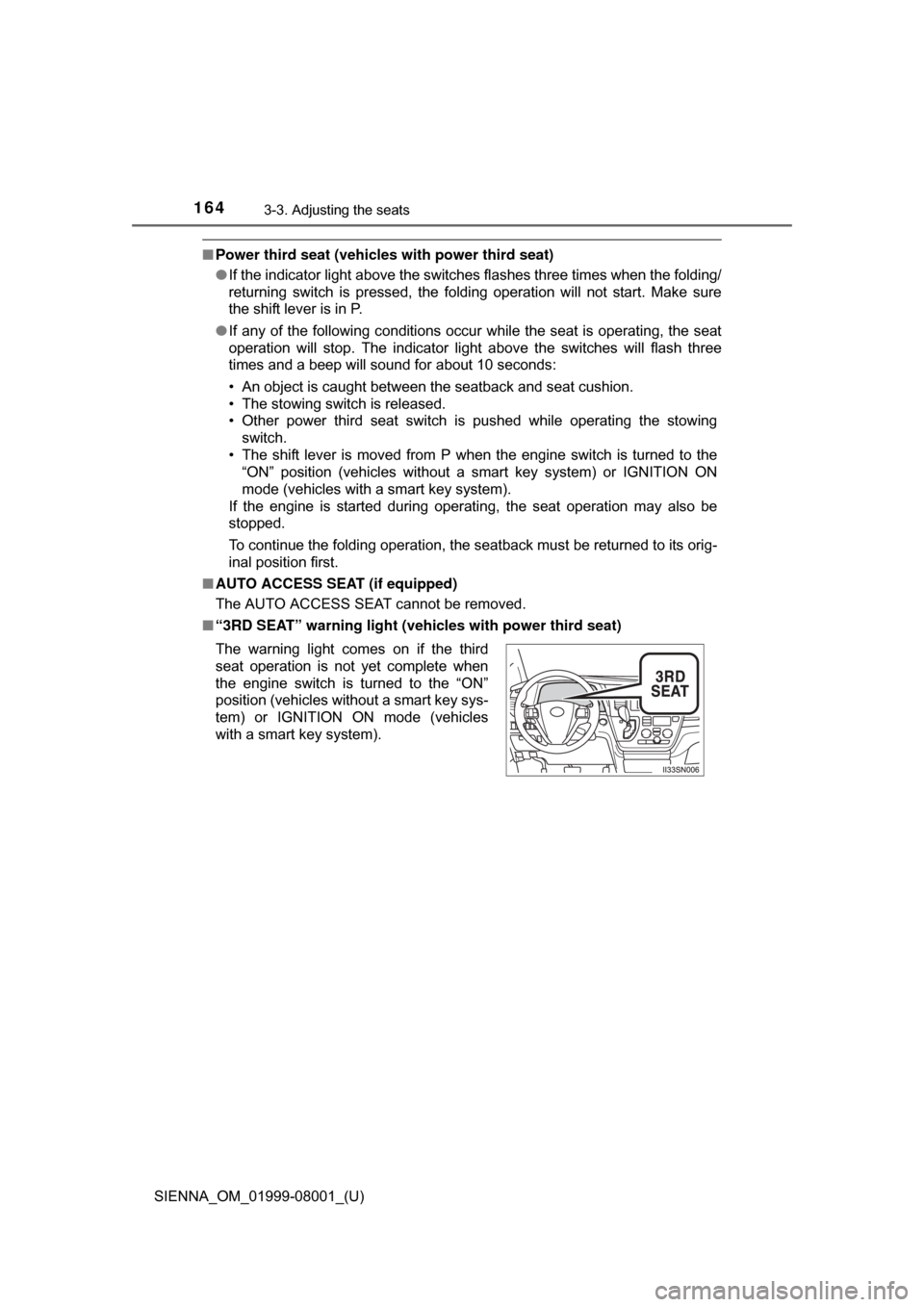
164
SIENNA_OM_01999-08001_(U)
3-3. Adjusting the seats
■Power third seat (vehicles with power third seat)
● If the indicator light above the switches flashes three times when the folding/
returning switch is pressed, the folding operation will not start. Make sure
the shift lever is in P.
● If any of the following conditions occur while the seat is operating, the seat
operation will stop. The indicator light above the switches will flash three
times and a beep will sound for about 10 seconds:
• An object is caught between the seatback and seat cushion.
• The stowing switch is released.
• Other power third seat switch is pushed while operating the stowing
switch.
• The shift lever is moved from P when the engine switch is turned to the “ON” position (vehicles without a smart key system) or IGNITION ON
mode (vehicles with a smart key system).
If the engine is started during operating, the seat operation may also be
stopped.
To continue the folding operation, the seatback must be returned to its orig-
inal position first.
■ AUTO ACCESS SEAT (if equipped)
The AUTO ACCESS SEAT cannot be removed.
■ “3RD SEAT” warning light ( vehicles with power third seat)
The warning light comes on if the third
seat operation is not yet complete when
the engine switch is turned to the “ON”
position (vehicles without a smart key sys-
tem) or IGNITION ON mode (vehicles
with a smart key system).
Page 166 of 664

166
SIENNA_OM_01999-08001_(U)
3-3. Adjusting the seats
WARNING
■Stowing the third seats
● Make sure that the seat path is clear before moving the seat. Otherwise,
injury may result from contact with, or by being pinched by parts of the
seat.
● Manual third seats: Do not sit on the third seat when it is in the stowed
position with the seatback upright.
● Power third seats: Do not continue the stowing operation when the indica-
tor above the stowing switch and returning switch comes on or flashes. An
object or a person may be caught in the seat.
● Power third seats: During the stowing operation, to prevent the vehicle
from moving, do not shift the shift lever out of P with the engine switch in
the “ON” position (vehicles without a smart key system) or IGNITION ON
mode (vehicles with a smart key system).
■ When adjusting the seat position or the ottoman (vehicles with Otto-
man seats)
Make sure to leave enough space around the feet so as not to get them
caught.
■ When using the ottoman ( vehicles with Ottoman seats)
● Do not sit on the ottoman. Seat belts may not be properly worn which may
result in death or serious injury.
● Stow the ottoman when you get in and out of the vehicle or when the otto-
man is not in use to avoid stumbling over it.
● Do not use the ottoman feature when the vehicle is in motion. The ottoman
feature should only be used when the vehicle is stationary. If the ottoman
feature is in use during an accident the lap belt may slide past the hips.
This could also result in restraint forces being applied to the abdomen or
your neck may contact the shoulder belt, increasing the risk of death or
serious injury.
Page 167 of 664
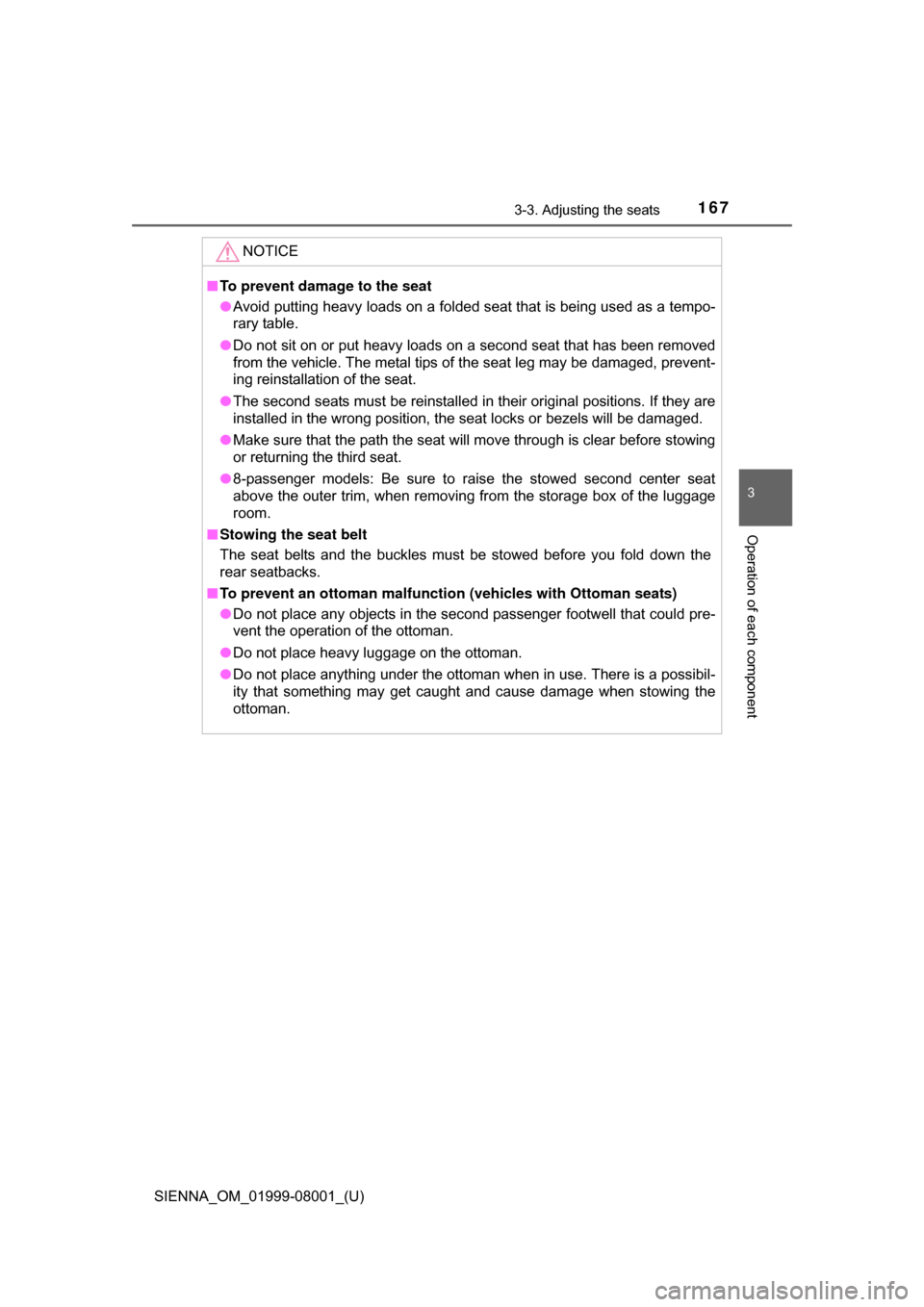
SIENNA_OM_01999-08001_(U)
1673-3. Adjusting the seats
3
Operation of each component
NOTICE
■To prevent damage to the seat
● Avoid putting heavy loads on a folded seat that is being used as a tempo-
rary table.
● Do not sit on or put heavy loads on a second seat that has been removed
from the vehicle. The metal tips of the seat leg may be damaged, prevent-
ing reinstallation of the seat.
● The second seats must be reinstalled in their original positions. If they are
installed in the wrong position, the seat locks or bezels will be damaged.
● Make sure that the path the seat will move through is clear before stowing
or returning the third seat.
● 8-passenger models: Be sure to raise the stowed second center seat
above the outer trim, when removing from the storage box of the luggage
room.
■ Stowing the seat belt
The seat belts and the buckles must be stowed before you fold down the
rear seatbacks.
■ To prevent an ottoman malfunctio n (vehicles with Ottoman seats)
● Do not place any objects in the second passenger footwell that could pre-
vent the operation of the ottoman.
● Do not place heavy luggage on the ottoman.
● Do not place anything under the ottoman when in use. There is a possibil-
ity that something may get caught and cause damage when stowing the
ottoman.
Page 174 of 664
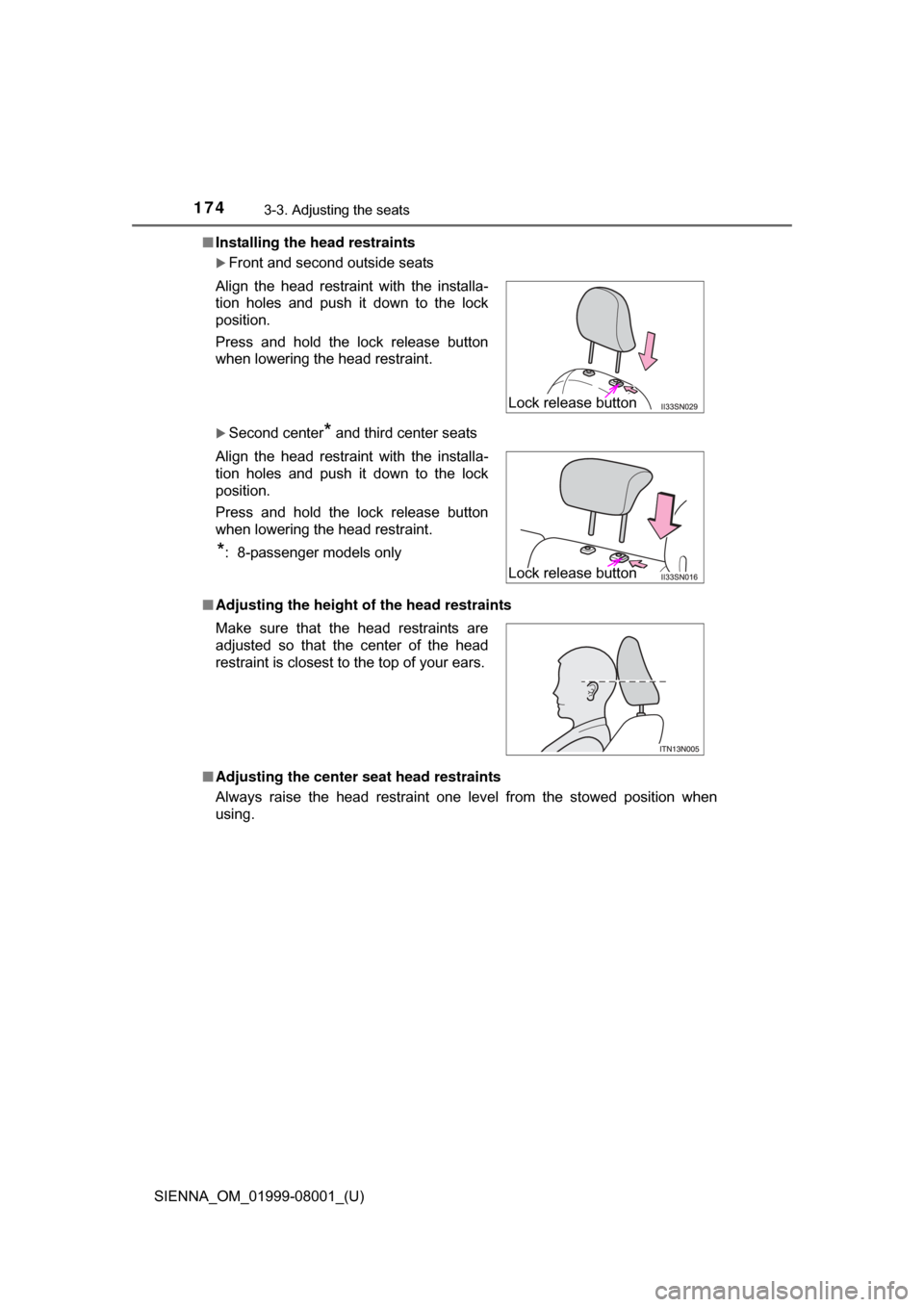
174
SIENNA_OM_01999-08001_(U)
3-3. Adjusting the seats
■Installing the head restraints
Front and second outside seats
Second center* and third center seats
■ Adjusting the height of the head restraints
■ Adjusting the center s eat head restraints
Always raise the head restraint one level from the stowed position when
using. Align the head restraint with the installa-
tion holes and push it down to the lock
position.
Press and hold the lock release button
when lowering the head restraint.
Align the head restraint with the installa-
tion holes and push it down to the lock
position.
Press and hold the lock release button
when lowering the head restraint.
*: 8-passenger models only
Make sure that the head restraints are
adjusted so that the center of the head
restraint is closest to the top of your ears.
Lock release button
Lock release button
Page 191 of 664

191
SIENNA_OM_01999-08001_(U)
4Driving
4-1. Before drivingDriving the vehicle ............. 192
Cargo and luggage ........... 201
Vehicle load limits ............. 207
Trailer towing (with towing package) ..... 208
Dinghy towing ................... 222
4-2. Driving procedures Engine (ignition) switch (vehicles without a
smart key system) ........... 223
Engine (ignition) switch (vehicles with a smart
key system) ..................... 226
Automatic transaxle........... 231
Turn signal lever................ 235
Parking brake .................... 236 4-3. Operating the lights
and wipers
Headlight switch ................ 237
Automatic High Beam ....... 242
Fog light switch ................. 247
Windshield wipers and washer ............................ 248
Rear window wiper and washer ............................ 252
4-4. Refueling Opening the fuel tank cap .................................. 254
4-5. Using the driving support systems
Cruise control .................... 257
Dynamic radar cruise control ............................. 261
Intuitive parking assist....... 273
Rear view monitor system ............................ 281
Driving assist systems ...... 291
PCS (Pre-Collision System)........................... 296
BSM (Blind Spot Monitor)........................... 303
4-6. Driving tips Winter driving tips ............. 311
Page 193 of 664

SIENNA_OM_01999-08001_(U)
1934-1. Before driving
4
Driving
Make sure that the parking brake is set and shift the shift lever to D.
Gently depress the accelerator pedal.
Release the parking brake.
■When starting off on a uphill (vehicles with a hill-start assist control sys-
tem)
The hill-start assist control is available. ( P. 291)
■ Driving in the rain
●Drive carefully when it is raining, because visibility will be reduced, the win-
dows may become fogged-up, and the road will be slippery.
● Drive carefully when it starts to rain, because the road surface will be espe-
cially slippery.
● Refrain from high speeds when driving on an expressway in the rain,
because there may be a layer of water between the tires and the road sur-
face, preventing the steering and brakes from operating properly.
■ Engine speed while driving
In the following conditions, the engine speed may become high while driving.
This is due to automatic up-shifting control or down-shifting implementation to
meet driving conditions. It does not indicate sudden acceleration.
●The vehicle is judged to be driving uphill or downhill
● When the accelerator pedal is released
■ Breaking in your new Toyota
To extend the life of the vehicle, observing the following precautions is recom-
mended:
●For the first 200 miles (300 km):
Avoid sudden stops.
● For the first 500 miles (800 km):
Do not tow a trailer.
● For the first 1000 miles (1600 km):
• Do not drive at extremely high speeds.
• Avoid sudden acceleration.
• Do not drive continuously in low gears.
• Do not drive at a constant speed for extended periods.
■ Drum-in-disc type parking brake system
Your vehicle has a drum-in-disc type parking brake system. This type of brake
system needs bedding-down of the brake shoes periodically or whenever the
parking brake shoes and/or drum are replaced. Have your Toyota dealer per-
form the bedding down operation.
Starting off on a steep uphill
1
2
3
Page 201 of 664
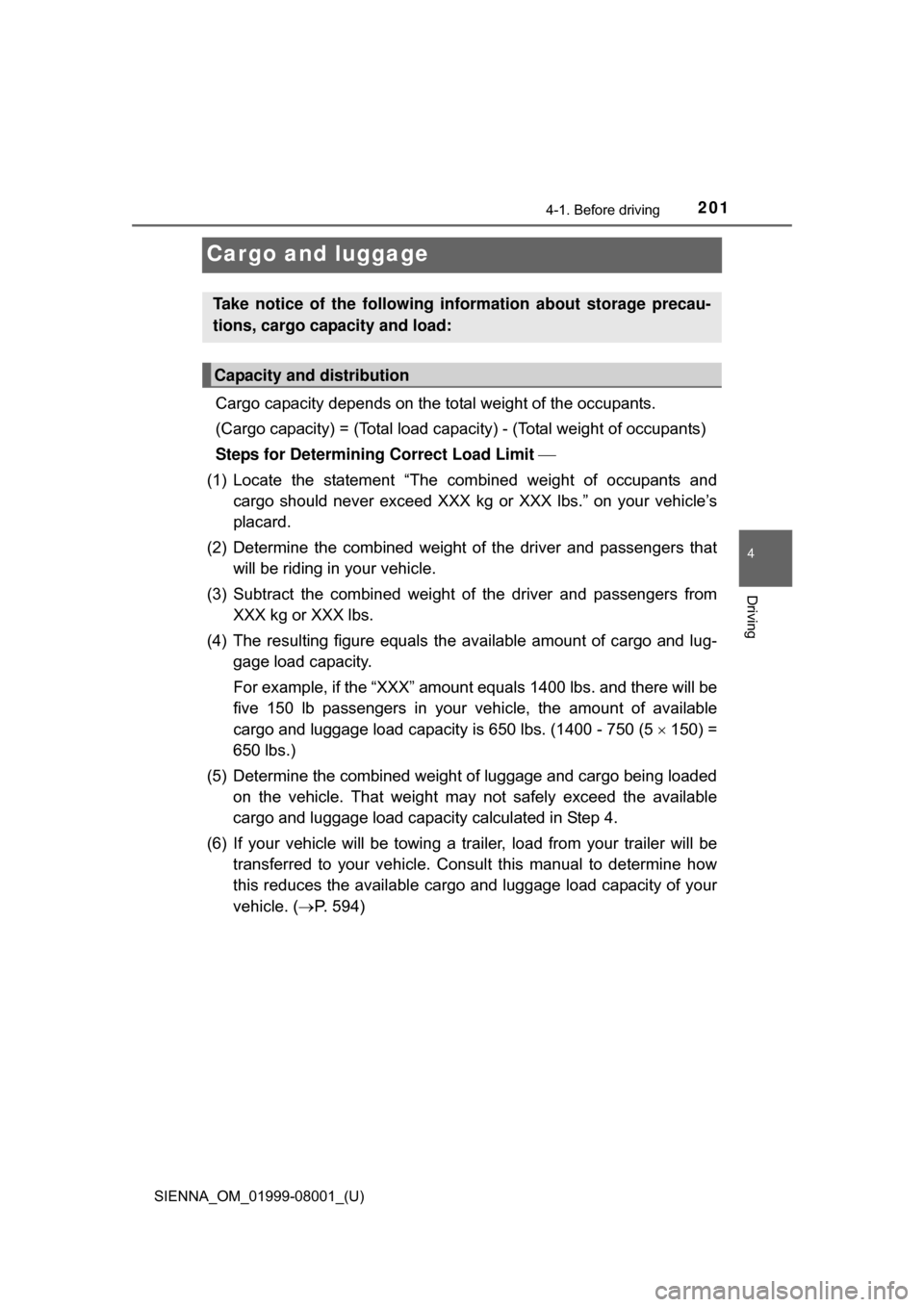
201
SIENNA_OM_01999-08001_(U)
4-1. Before driving
4
Driving
Cargo and luggage
Cargo capacity depends on the total weight of the occupants.
(Cargo capacity) = (Total load capacity) - (Total weight of occupants)
Steps for Determining Correct Load Limit
(1) Locate the statement “The combined weight of occupants and cargo should never exceed XXX kg or XXX lbs.” on your vehicle’s
placard.
(2) Determine the combined weight of the driver and passengers that will be riding in your vehicle.
(3) Subtract the combined weight of the driver and passengers from
XXX kg or XXX lbs.
(4) The resulting figure equals the available amount of cargo and lug- gage load capacity.
For example, if the “ XXX” amount equals 1400 lbs. and there will be
five 150 lb passengers in your v ehicle, the amount of available
cargo and luggage load capacity is 650 lbs. (1400 - 750 (5 150) =
650 lbs.)
(5) Determine the combined weight of luggage and cargo being loaded on the vehicle. That weight ma y not safely exceed the available
cargo and luggage load capacity calculated in Step 4.
(6) If your vehicle will be towing a tr ailer, load from your trailer will be
transferred to your vehicle. Consult this manual to determine how
this reduces the available cargo and luggage load capacity of your
vehicle. ( P. 594)
Take notice of the following information about storage precau-
tions, cargo capacity and load:
Capacity and distribution
Page 205 of 664
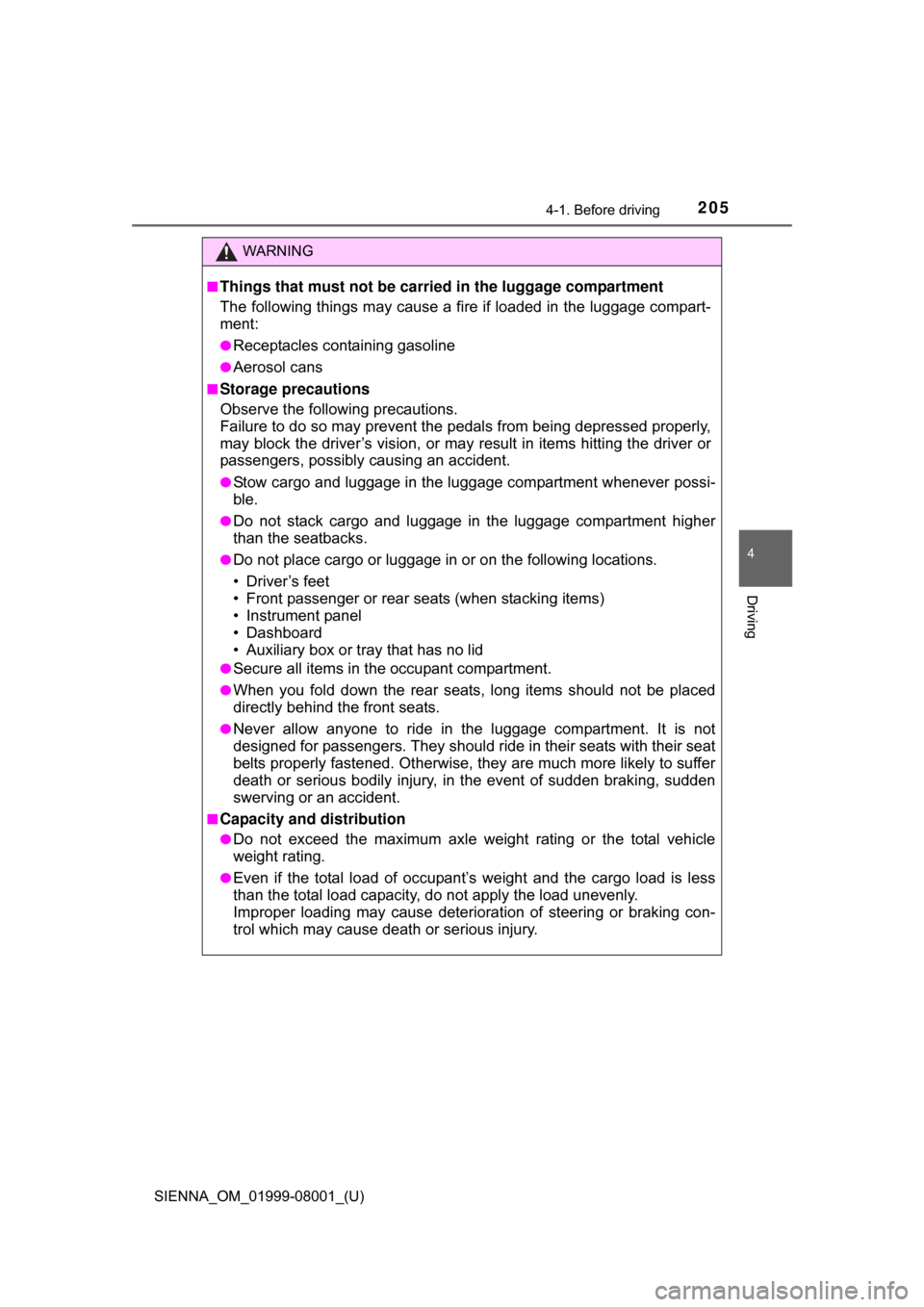
SIENNA_OM_01999-08001_(U)
2054-1. Before driving
4
Driving
WARNING
■Things that must not be carried in the luggage compartment
The following things may cause a fire if loaded in the luggage compart-
ment:
●Receptacles containing gasoline
●Aerosol cans
■Storage precautions
Observe the following precautions.
Failure to do so may prevent the pedals from being depressed properly,
may block the driver’s vision, or may result in items hitting the driver or
passengers, possibly causing an accident.
●Stow cargo and luggage in the luggage compartment whenever possi-
ble.
●Do not stack cargo and luggage in the luggage compartment higher
than the seatbacks.
●Do not place cargo or luggage in or on the following locations.
• Driver’s feet
• Front passenger or rear seats (when stacking items)
• Instrument panel
• Dashboard
• Auxiliary box or tray that has no lid
●Secure all items in the occupant compartment.
●When you fold down the rear seats, long items should not be placed
directly behind the front seats.
●Never allow anyone to ride in the luggage compartment. It is not
designed for passengers. They should ride in their seats with their seat
belts properly fastened. Otherwise, they are much more likely to suffer
death or serious bodily injury, in the event of sudden braking, sudden
swerving or an accident.
■Capacity and distribution
●Do not exceed the maximum axle weight rating or the total vehicle
weight rating.
●Even if the total load of occupant’s weight and the cargo load is less
than the total load capacity, do not apply the load unevenly.
Improper loading may cause deterioration of steering or braking con-
trol which may cause death or serious injury.